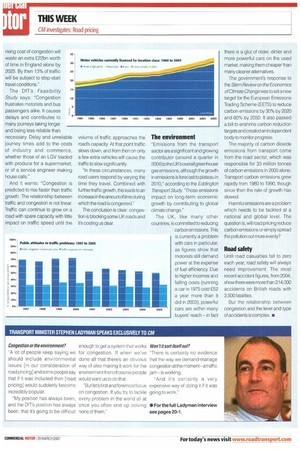What's the motivation?
Page 27

Page 28

If you've noticed an error in this article please click here to report it so we can fix it.
Congestion is a millstone around the neck of British industry, costing literally bkons of pounds a year. Everyone involved with road transport already knows that, and the word is spreading. According tea British Social Attitudes Survey, 30% of the population understand that congestion is a serious problem on motorwaysand 50% worry about urban traff ic jams (see graph).
The Department for Transport's Feasibility Study of Road Pricing in the UK says: "Congestion is the, major economic cost. The national transport model forecasts that without further action the cost of congestion will rise relative to environment and safety costs. The volume of traff ic on our roads is also closely linked with the wider costs of road transport, such as air quality. The discussion of the causes of, and strategies for, addressing congestion should therefore be read with the wider effects in mind!'
In 1980 there were 19.2 million licensed vehicles on UK roads. By 2005 that had risen 79% to 32.9 million. Unsurprisingly during the same period total traffic increased by 82%, from 277 to 504 billion vehicle kilometres (byk).
Most of this growth has come from car traffic, which rose by 85% over the same period to 397byk; van traffic doubled to 63bvk and L_GV traffic rose from 20 to 29bvk. In other words, the trucks that many motorists blame fortraff ic jams have fallen as a proportion of total traffic -operators are not the perpetrators of congestion; they are its victims.
The 2006 Eddington Transport Studysays:"Delays and unreliability on the network have direct costs to people and businesses, increasing business costs and affecting productivity and innovation. Eliminating existing congestion on the road network would be worth some £7-8bn of GDP per annum. It would never be economically rational to eliminate this completely but it does illustrate that the sums involved are far from trivial.
'Travel demand is growing rapidly due to continued economic success and is densely concentrated on certain parts of the networks at certain times of the day. As a result, parts of the system are under serious strain. if left unchecked, the rising cost of congestion will waste an extra 222bn worth of time in England alone by 2025. By then 13% of traffic will be subject to stop-start travel conditions."
The Dfrs Feasibility
Study says: "Congestion 10 frustrates motorists and bus passengers alike. It causes delays and contributes to many purneys taking longer and being less reliable than necessary. Delay and unreliable journey times add to the costs of industry and commerce, whether those of an LGV loaded with produce for a supermarket, or of a service engineer making house calls."
15
And it warns: "Congestion is predicted to rise faster than traffic growth. The relationship between traffic and congestion is not linear. Traffic can continue to grow on a road with spare capacity with little impact on traffic speed until the volume of traffic approaches the road's capacity. At that point traffic slows down, and from then on only a few extra vehicles will cause the traffic to slow significantly.
"In these circumstances, many road users respond by varying the time they travel. Combined with further traff ic growth, this leads to an increase in theamount of time during which the road is congested."
The conclusion is clear: congestion is blocking some UK roads and it's costing us dear.
The environment
"Emissions from the transport sector are a sign if icant and growing contributor (around a quarter in 2004)tothe UK's overall greenhouse gas emissions, although the growth in emissions is forecastto plateau in 2010," according to the Eddington Transport Study. "Those emissions impact on long-term economic growth by contributing to global climate change."
The UK, like many other countries, is committed to reducing carbon emissions. This is currently a problem with cars in particular, as figures show that motorists still demand power at the expense of fuel efficiency. Due to higher incomes and falling costs (running a car in 1975 cost 252 a year more than it did in 2003), powerful cars are within many buyers' reach in fact there is a glut of older, dirtier and more powerful cars on the used market, making them cheaper than many cleaner alternatives.
The government's response to the Stern Reviewon the Economics of Climate Changewas to set anew target for the European Emissions Trading Scheme (EETS) to reduce carbon emissions by 30% by 2020 and 60% by 2050. It also passed a bill to enshrine carbon reduction targets and created an independent body to monitor progress.
The majority of carbon dioxide emissions from transport come from the road sector, which was responsible for 33 million tonnes of carbon emissions in 2005 alone. Transport carbon emissions grew rapidly from 1980 to 1990, though since then the rate of growth has slowed.
Harmful emissions area problem which needs to be tackled at a national and global level. The question is, will road pricing reduce carbon emissions or simply spread the pollution out more evenly?
Road safety
Until road casualties fall to zero each year, road safety will always need improvement. The most recent accident figures, from 2004, show there were more than 214,000 accidents on British roads with 3,500 fatalities.
But the relationship between congestion and the level and type of accidents is complex. •
























































































































































































